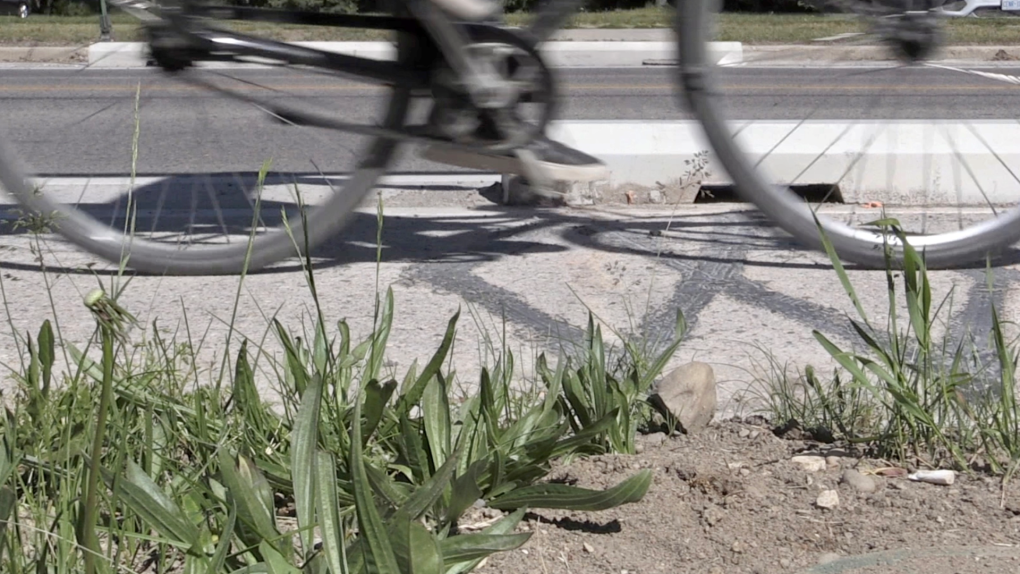Critics say London, Ont.’s bike lanes are under-utilized and seasonal— but here’s the ridership data
If you build it, they will ride.
The installation of new protected bike lanes can be a contentious issue for neighbouring homes and businesses because of the impact to traffic lanes and street parking.
However, new data reveals that London, Ont.’s expanding network if cycling infrastructure is experiencing a ridership boom.
Between 2021 and 2022, ridership on protected bike lanes along Dundas Street and Colborne Street increased 48 per cent to an average of 12,300 riders each month.
So far this year the trend continues.
“Year over year on our core cycling network, it’s another 45 to 50 per cent increase,” explained the city’s Manager of Active Transportation Daniel Hall. “People are learning about the lanes and they’re becoming habits.”
“Doesn’t surprise me at all,” said Andrew Hunniford, manager of the new, larger London Bicycle Cafe on Thames Street. “We’ve been looking at that same data for a long time. We’re not aggregating demand here for bicycles; we’re utilizing the demand that’s already here.”
Electronic counting devices have been installed within the asphalt of many core area bike lanes.
Each time a bicycle or scooter rides over the device its presence is added to the monthly total.
 A cyclist passed over an electronic counting device buried in a bike lane in London, Ont. on May 26, 2023. (Daryl Newcombe)
A cyclist passed over an electronic counting device buried in a bike lane in London, Ont. on May 26, 2023. (Daryl Newcombe)
The data also shows that Londoners are no longer just fair weather cyclists.
Last winter, an average of 2,600 bikes per month were recorded on the Dundas Street protected bike lanes.
However, the painted bike lanes on Ridout Street only counted 1,000 cyclists.
“Protected bike lanes have shown to retain more of the summer ridership because of the feeling of safety [and] because we are snowplowing them,” suggested Hall.
Hunniford believes the ridership data shows the growing demand for more active transportation infrastructure.
“I don’t think it’s a coincidence that where you see the [construction] cranes building the tallest residential towers right now in the downtown, they are closest to the best active transportation infrastructure that we offer,” he added.
Last year, city council authorized spending a total of $40 million from the three levels of government to fast track cycling and pedestrian infrastructure projects across the city.
“The city is committed to improving safety, to improving the viability of cycling, and as it continues to grow and we expand the network, we’re only going to see more ridership,” predicted Hall.
CTVNews.ca Top Stories

Banks lower prime rates following Bank of Canada move
Canadian financial institutions are lowering their prime lending rates to match the decrease announced by the Bank of Canada.
Police locate labyrinth of tunnels connecting tents to generator in Hamilton encampment
Hamilton police say that they discovered a series of “man-made holes and tunnels” during a patrol of a downtown encampment earlier this week.
Police identify murder victim whose skull was found in Ontario river more than three decades ago
Police have identified a man whose skull was found almost 40 years ago in a Peterborough-area river.
Canada Post strike: Talks deadlocked as sides clash on wages
Negotiations between Canada Post and the union representing its workers appear to be in a deadlock as the two sides remain far apart on wages and other issues.
Certain foods may disrupt your body's fight against cancer cells, study says
The food you eat may be affecting your body’s ability to fight cancer cells in the colon, according to a new study.
Poilievre's Conservatives still in majority territory: Nanos seat projections
The Liberals' promise of a temporary GST break and $250 rebate cheques haven't benefited Prime Minister Justin Trudeau and his minority government when it comes to public support, according to Nanos Research data.
George Kresge Jr., who wowed talk show audiences as the The Amazing Kreskin, dies at age 89
George Joseph Kresge Jr., who was known to generations of TV watchers as the mesmerizing entertainer and mentalist The Amazing Kreskin, has died at age 89.
Meta working on resolving Facebook, Instagram outage
Meta users are experiencing a widespread outage, including applications like WhatsApp, Instagram, Facebook and Facebook Messenger, according to third-party website Downdetector.com. Meta acknowledged the issue and is working on resolving the outage.
'Baseball-sized hail': Toronto man owes car rental company $18K after hailstorm
A Toronto man is on the hook for about $18,000 after a car he rented over the summer was pelted by baseball-sized hail.


































